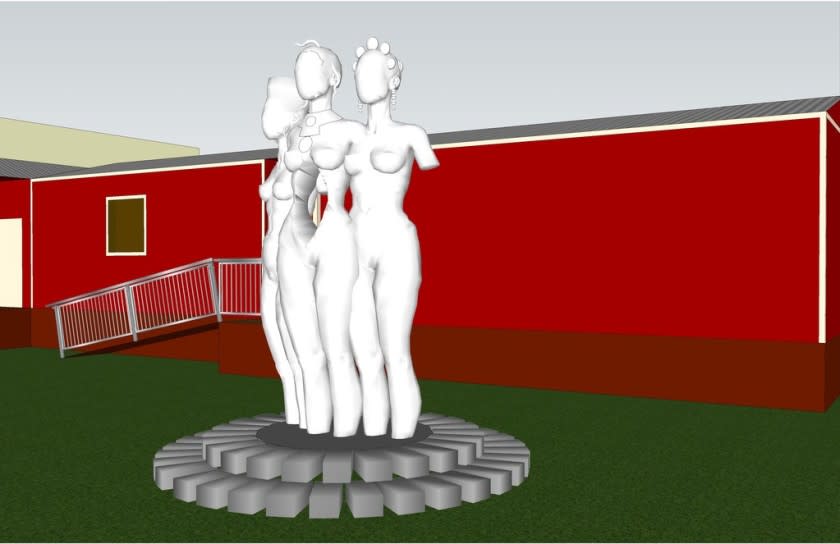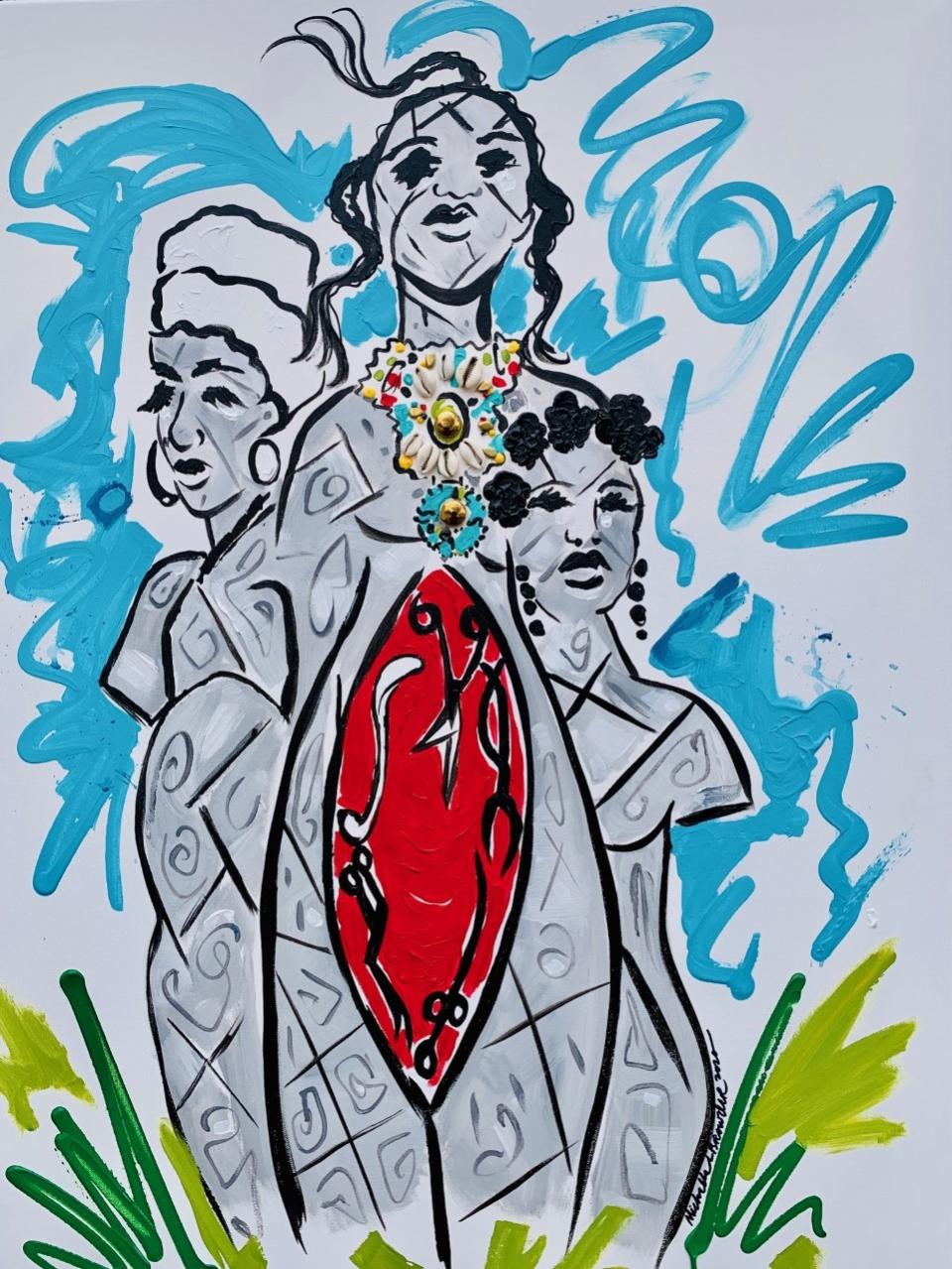Enslaved women suffered in gynecology experiments. A monument project for them visits L.A.

- Oops!Something went wrong.Please try again later.
You may have heard of Dr. J. Marion Sims, the so-called “father of modern gynecology.” It's less likely you know the “mothers of gynecology.”
In the mid-1800s in Montgomery, Ala., Sims conducted experimental surgeries on about 11 enslaved women. None of them gave consent to be operated on. None of them received anesthesia. Their suffering has largely been forgotten, overshadowed by Sims’ medical achievements.
Montgomery-based artist and activist Michelle Browder is building awareness for the forgotten mothers of gynecology — literally. She’s erecting a large-scale sculptural monument to the women to be installed in Montgomery — and she is asking for your help.
Browder will be passing through Los Angeles this weekend, after picking up the sculpture's steel armature from a fabricator in Las Vegas and before heading to San Francisco, where she will build out the work. On Saturday morning, she will hold a free event at the North Venice Little League parking lot. She’s inviting Angelenos to meet her and to bring metal objects — brass candlesticks, copper pots, stainless steel silverware, spare bicycle parts — to be melted down as material for the 15-foot figurative sculpture commemorating the women.
“Discarded objects represent how Black women have been treated in this country,” Browder said. “But it also represents the beauty that’s in the broken and the discarded. And recycled materials — we’re being mindful of the planet. It’s also about environmental justice.”
The sculpture will feature three enslaved women that Sims mentioned in his notes: Anarcha, who endured 30 surgeries, as well as Betsey and Lucy. The work will sit on a pedestal of red bricks, each inscribed with the names of women who have suffered losses.
“Women from the ’60s civil rights movement and the new civil rights movement,” Browder said. “Women who have lost their children, like Sybrina Fulton, Trayvon Martin’s mom, and the mother of George Floyd — he cried out for his mom as he was dying. Mothers like Eartha Kitt, who lost her career because she stood for justice; Nina Simone, who didn’t have the opportunity to be the classical pianist she wanted to be because of the color of her skin.”
Saturday’s event also will serve as a memorial to the mothers of gynecology. Browder will lead a discussion addressing racial justice, the legacy of slavery and reproductive rights, among other topics.

In addition to being a mixed-media artist — her work is on view at the Alabama Department of Archives and History in downtown Montgomery — Browder is the founder and director of the Montgomery-based nonprofit I Am More Than. The arts-based youth empowerment organization celebrates its 10th anniversary this year. Browder also leads local “truth tours,” as she calls them, addressing the region’s history, slavery and civil rights through her company More Than Tours.
Browder, who grew up in Verbena, Ala., first learned of the mothers of gynecology in college at the Art Institute of Atlanta. Their stories haunted her. She conceived of the monument about 10 years ago while leading one of her tours.
“I was telling people about J. Marion Sims, how [his statue] still stands at our state’s capitol. Here we are in the 21st century and we’re still celebrating people who did these unspeakable crimes,” Browder said. “But Alabama is not a place where they’ll remove statues. So I said, ‘Well, what about the mothers? We need to do something to remember them, to speak their truths.’”
About six years ago, the mothers of gynecology began to weigh heavily on Browder, and she rededicated herself to making the monument. She refined the vision for the work in January 2020 when, while visiting San Francisco, friends introduced her to Bay Area artist Dana Albany, who creates enormous sculptures using recycled materials. Albany promised to teach Browder how to weld.
After Browder designed the work, she enlisted Montgomery sculptor Deborah Shedrick, a friend, to consult. “She added her twist to the design and brought in the fistula,” Browder said, adding that the vesicovaginal fistula — a tear between the bladder and the vagina that can occur during childbirth — was the focus of Sims' experimental operations.
The Las Vegas armature fabricator and Browder will drive the skeletal structure from Las Vegas to L.A. on Friday. After Saturday’s event, they’ll continue on to San Francisco, where Browder will spend the rest of March — Women’s History Month — with Albany laying the “metal skin” onto the work. Shedrick will join them for several weeks.
The weeklong journey home will include stops in six cities for outdoor events and fundraisers: Dallas and Austin, Texas; Greenville, Miss.; Baton Rouge and Shreveport, La.; and Africatown in Mobile, Ala., where the last slave ship from Africa to the U.S. landed.
“The trip is about reclaiming history and envisioning a brighter future,” Browder said. “We wanted to make it a pilgrimage so that these women, they’ll be reborn. We want to welcome them back to Montgomery but this time to be handled with care.”
Word of Browder’s journey spread organically among her friends, colleagues and former tour customers. Now the hashtag #themothersofgynecology is gaining momentum on social media. Gloria Steinem tweeted about it last week, and on Wednesday, Browder got a call from actress Gina Belafonte to say she was coming Saturday.
Browder and Shedrick hope to finish the work in time to install it on Mother's Day. The sculpture will sit outdoors at the More Up Campus in Montgomery. The complex houses the I Am More Than organization and a small art gallery, a resource center and a 32-bed student travel center. The three buildings are nestled on greenspace on a corner lot that Browder plans to turn into a park.
The sculpture is Phase 1 of a three-part project. Phase 2, once funds are raised, will be to renovate the student travel center. Phase 3 will turn the resource center into the Creative Changemakers Museum dedicated to the mothers of gynecology.
But first: dialogue. In April and May, while Browder and Shedrick put the final touches on the sculpture back in Montgomery, Browder will host welding workshops for women as well as community discussions on slavery and systemic racism, reproductive rights, and the health disparities illuminated by the COVID-19 pandemic and infant mortality rates. Browder said Montgomery has one of the highest infant mortality rates in the nation.
“It’s that legacy of slavery,” Browder said. “It’s shaped the structure of our healthcare system.”
The events Saturday and in the weeks that follow make up a collective healing odyssey, she said.
“Everyone talks about change and a reconciliation and a reckoning,” Browder said. “But it’s going to take all of us to get there. We have to start having these courageous conversations, lifting the veil of ignorance. And it’s going to take everyone to do that.”
This story originally appeared in Los Angeles Times.

